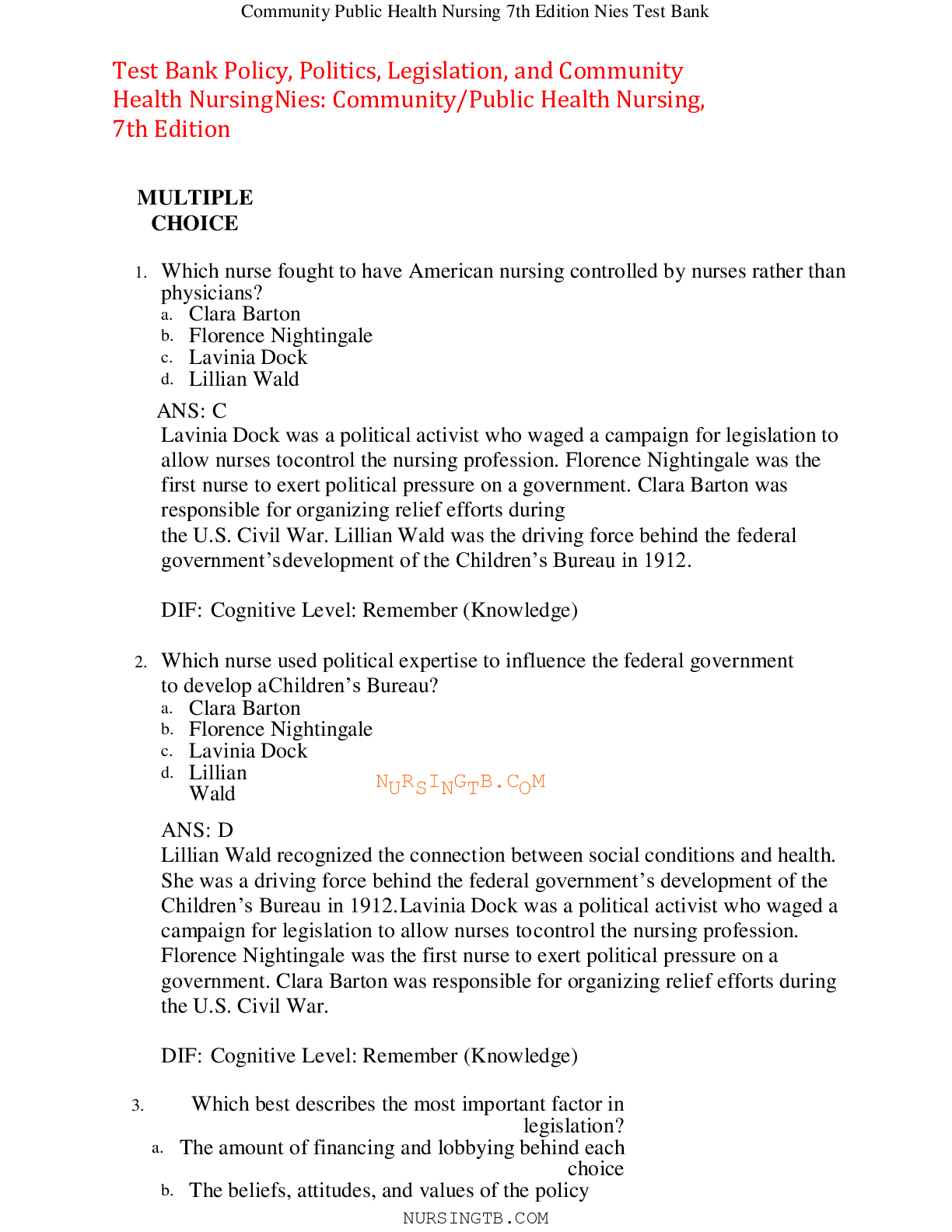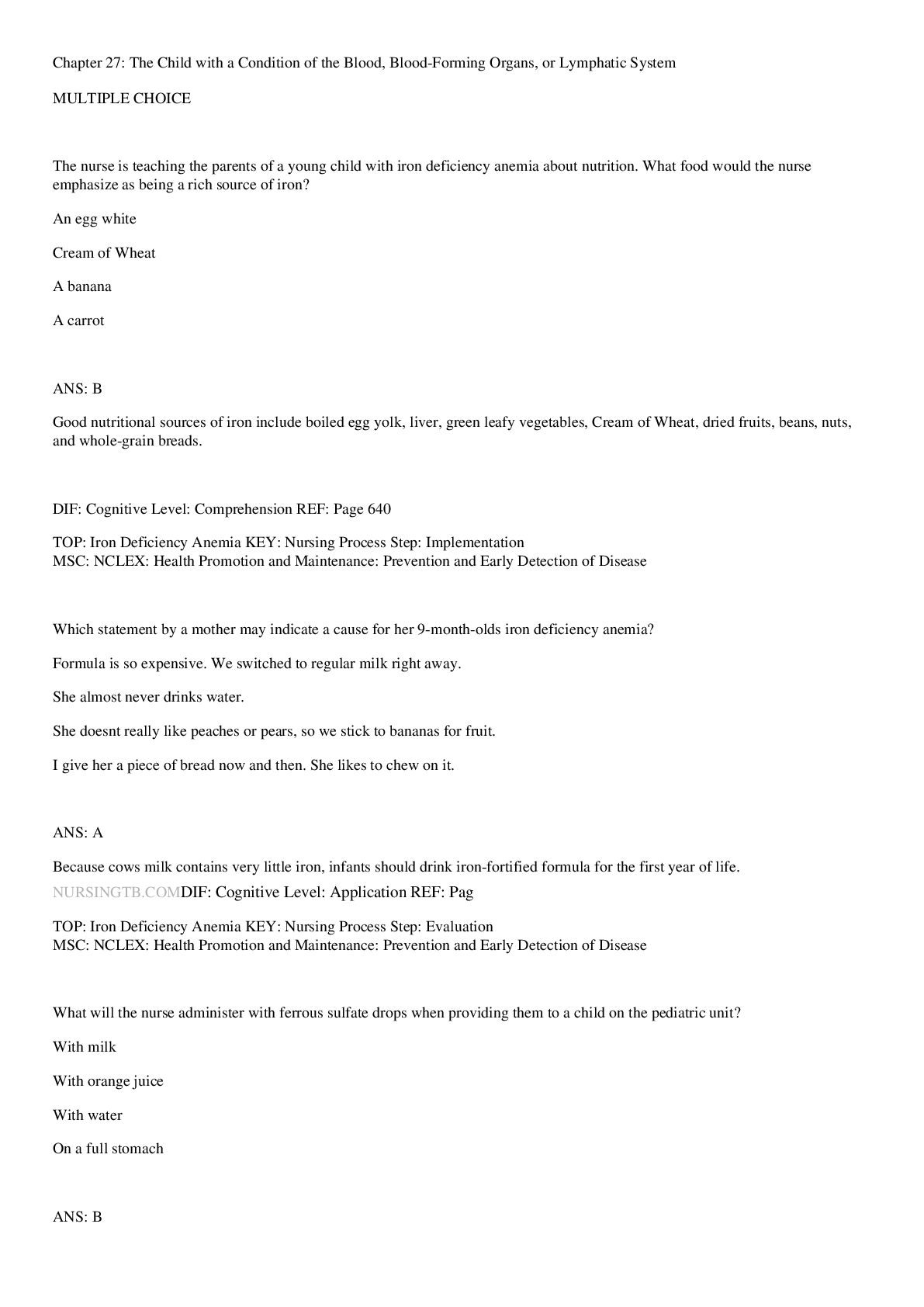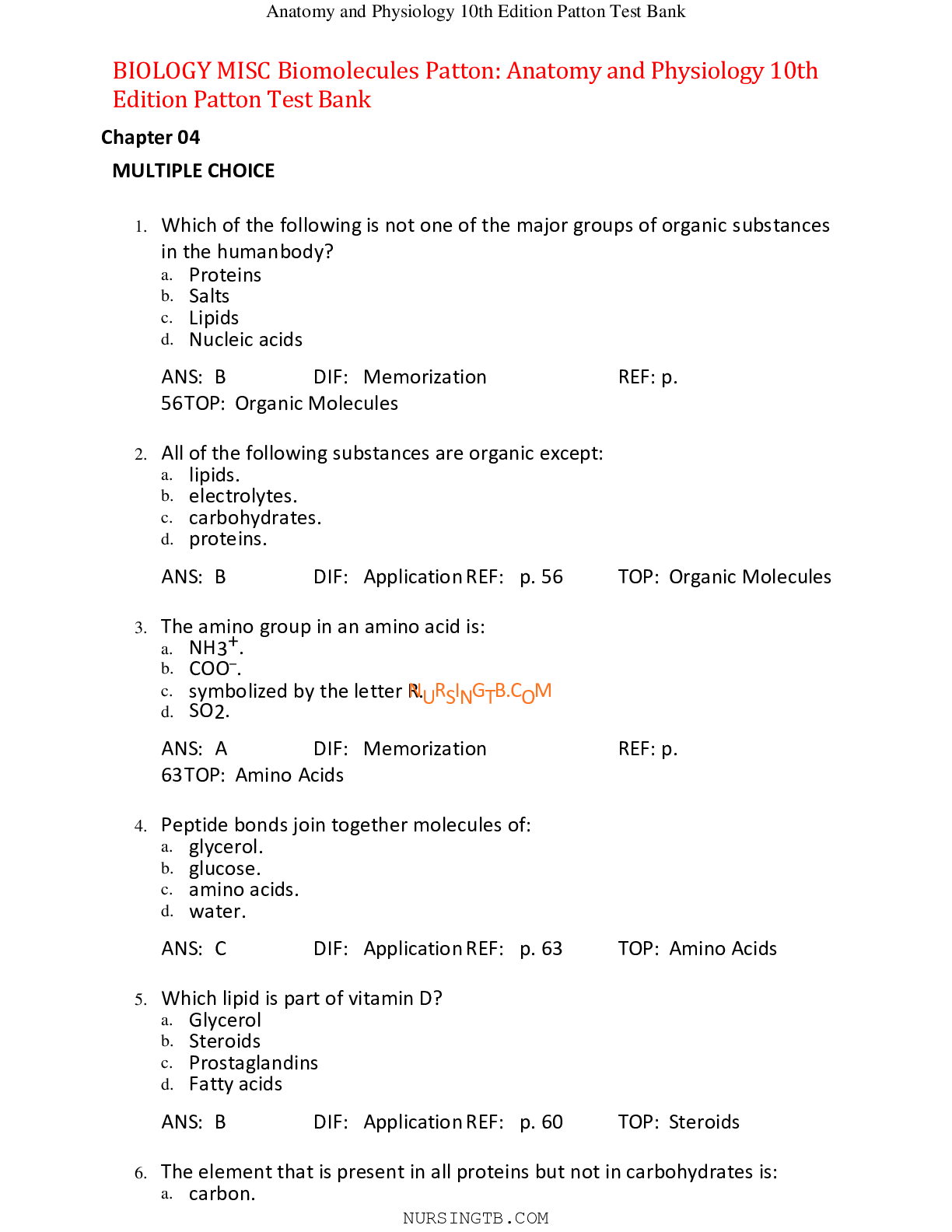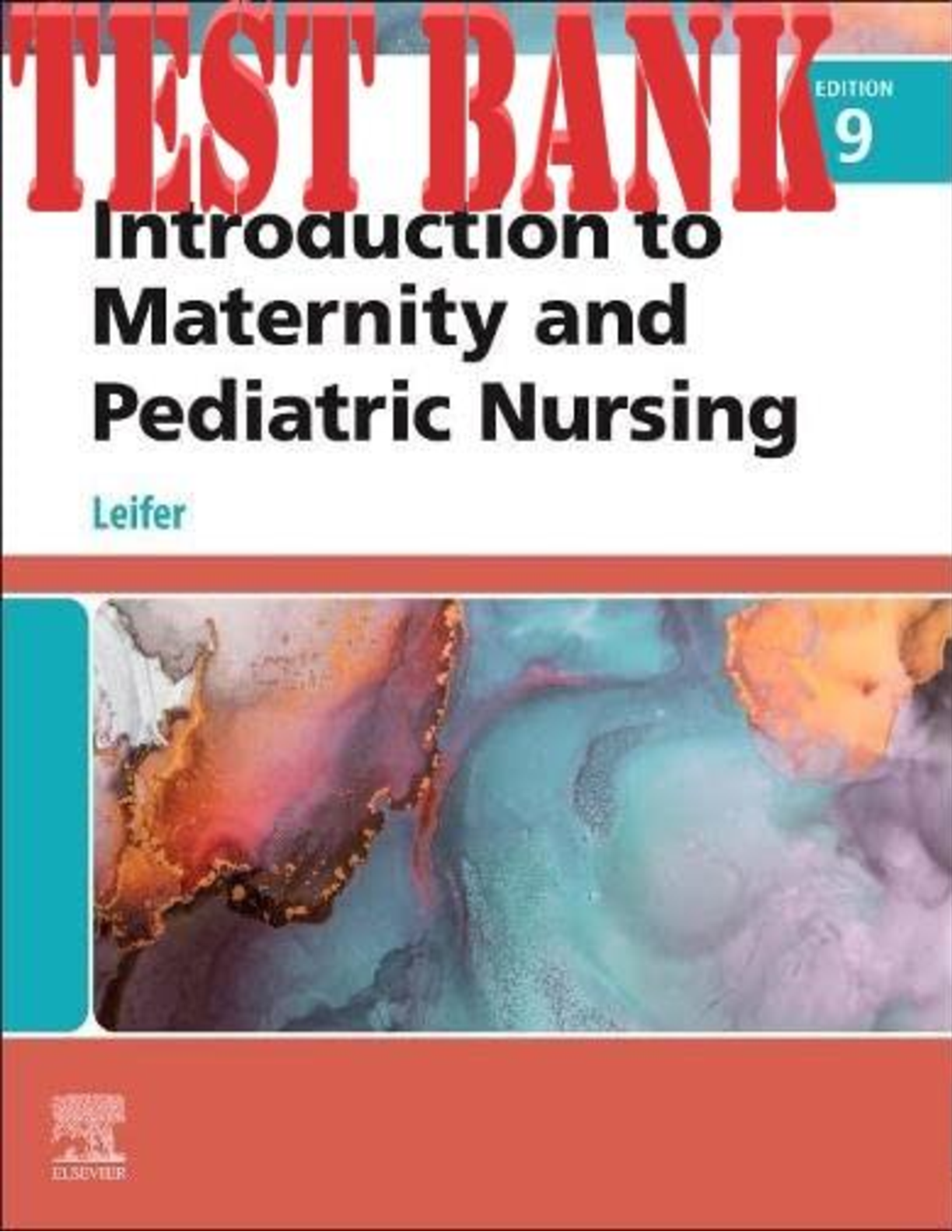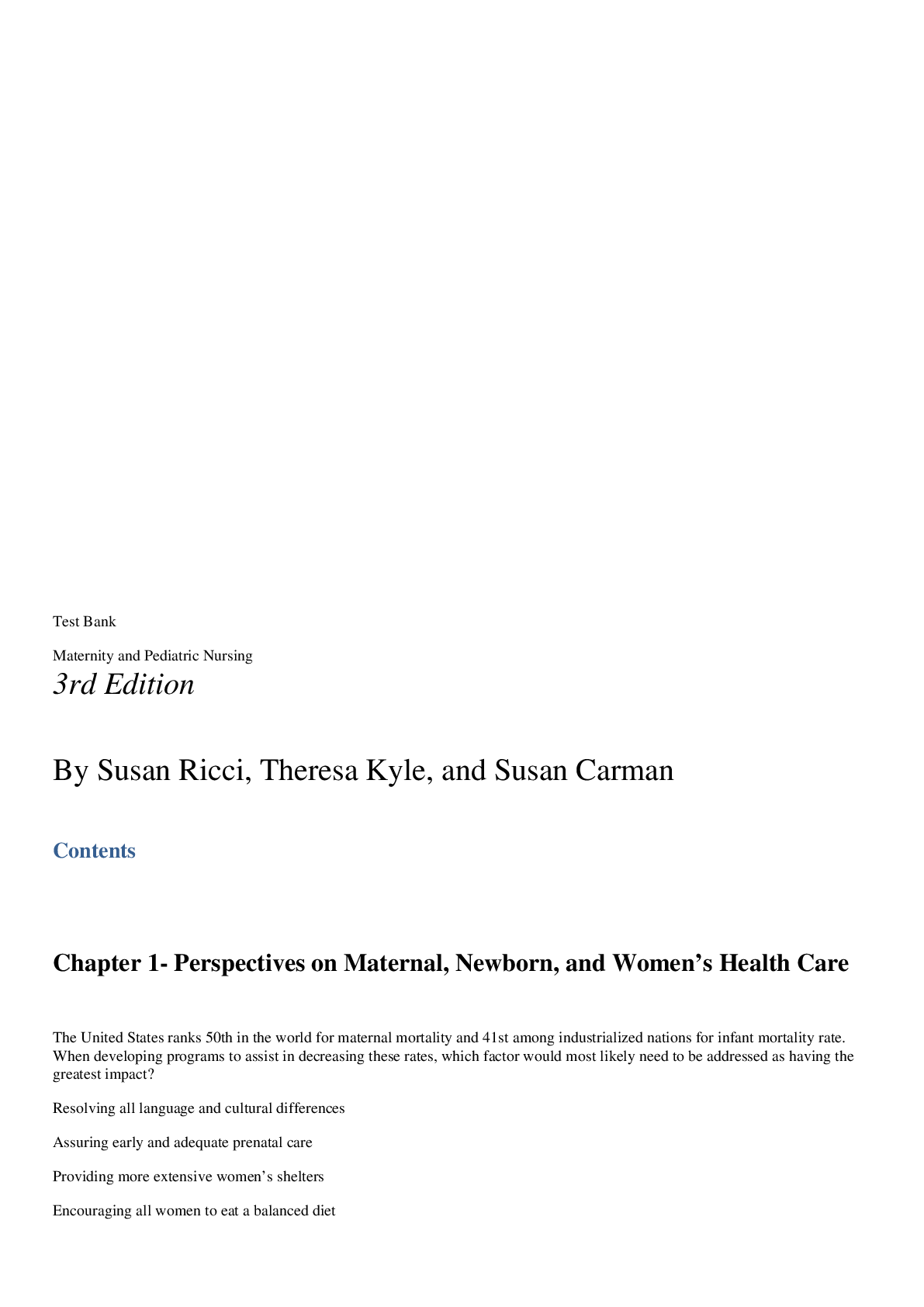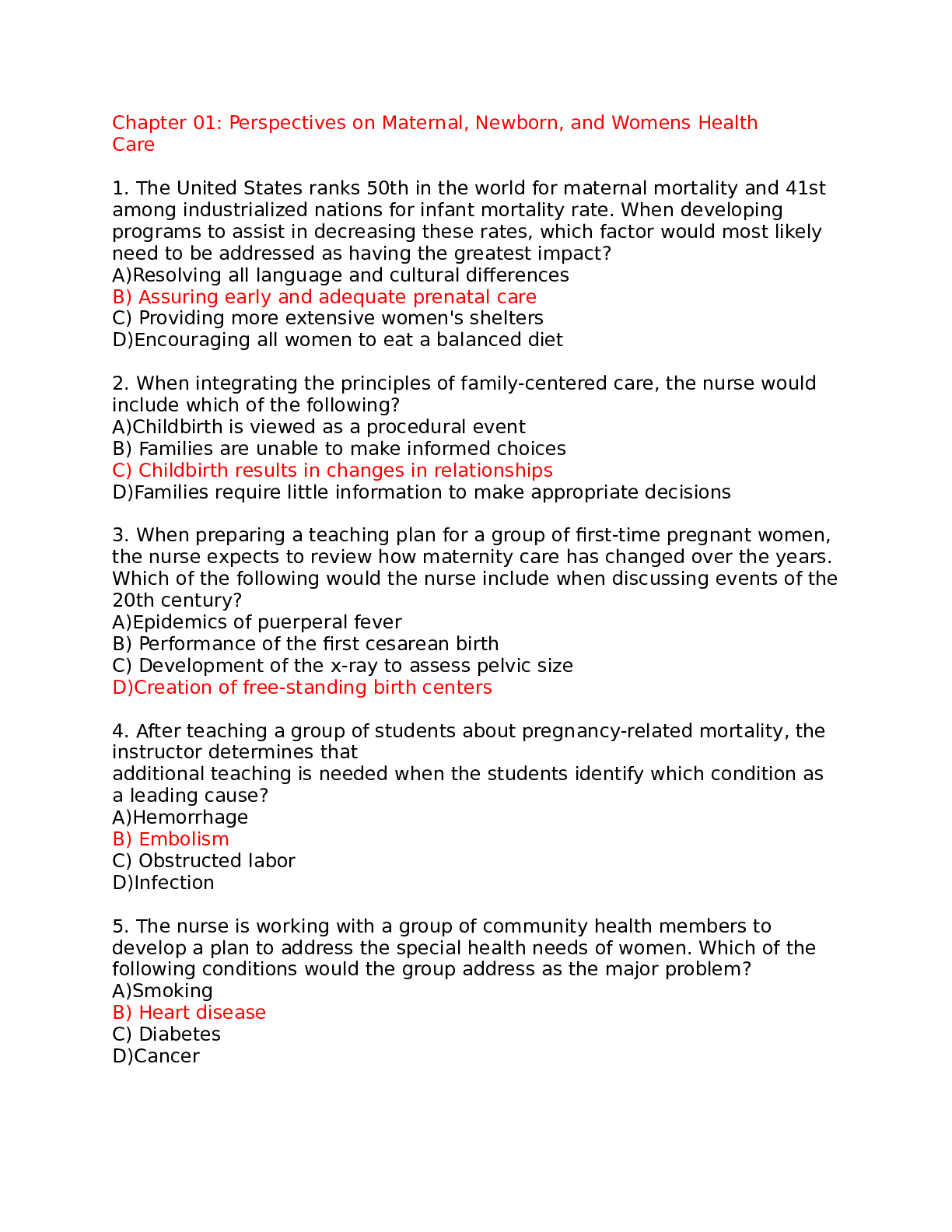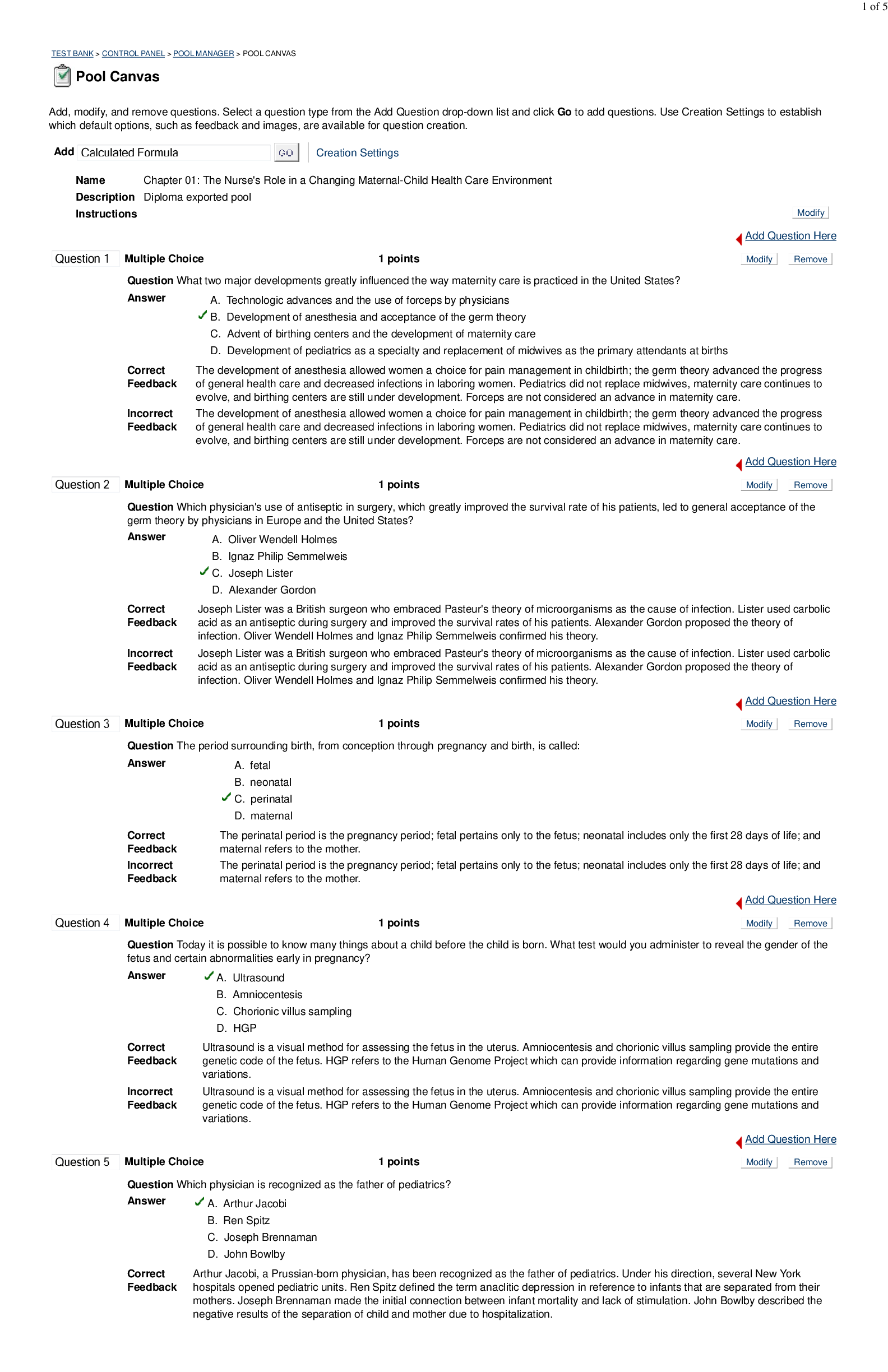*NURSING > TEST BANK > Test Bank - Introduction to Maternity and Pediatric Nursing 8e (by Leifer) The Child with a Sensory (All)
Test Bank - Introduction to Maternity and Pediatric Nursing 8e (by Leifer) The Child with a Sensory or Neurological Condition,100% CORRECT
Document Content and Description Below
Test Bank - Introduction to Maternity and Pediatric Nursing 8e (by Leifer) The Child with a Sensory or Neurological Condition MULTIPLE CHOICE 1. A parent comments that her infant has had several e... ar infections in the past few months. Why are infants more susceptible to otitis media? a. Infants are in a supine or prone position most of the time. b. Sucking on a nipple creates middle ear pressure. c. They have increased susceptibility to upper respiratory tract infections. d. The eustachian tube is short, straight, and wide. ANS: D An infants eustachian tubes are short, wide, and straight, allowing microorganisms easy access to the middle ear. DIF: Cognitive Level: Knowledge REF: Page 538 TOP: Otitis Media KEY: Nursing Process Step: Data Collection MSC: NCLEX: Physiological Integrity: Physiological Adaptation 2. What statement by a patients mother leads the nurse to determine she understands instructions about administering an oral antibiotic for otitis media? a. I will continue using the medication until symptoms are relieved. b. I will share the medicine with siblings if their symptoms are the same. c. I will give the medication with a glass of milk. d. I will administer prescribed doses until all the medication is used. ANS: D Antibiotic therapy for otitis media is continued until the prescribed amount has been completed, even if symptoms are alleviated. NURSINGTB.COM DIF: Cognitive Level: Application REF: Page 540 OBJ: 2 TOP: Otitis Media KEY: Nursing Process Step: Evaluation MSC: NCLEX: Safe, Effective Care Environment: Safety and Infection Control 3. Which situation would cause the nurse to suspect a hearing impairment? a. 3-month-old infant with a positive Moro reflex b. 15-month-old toddler who is babbling c. 18-month-old toddler who is speaking one-syllable words d. 24-month-old toddler who communicates by pointing ANS: D The child who is not making verbal attempts by 18 months should undergo a complete physical examination. DIF: Cognitive Level: Analysis REF: Page 540 OBJ: 3 TOP: Hearing Impairment KEY: Nursing Process Step: Data Collection MSC: NCLEX: Health Promotion and Maintenance: Prevention and Early Detection of Disease 4. What is the best way for the nurse to communicate with a 10-year-old child who has a hearing impairment? a. Use gestures and signs as much as possible. b. Let the childs parents communicate for her. c. Face the child and speak clearly in short sentences. d. Recognize that the childs ability to communicate will be on a 6-year-old childs level. ANS: C The nurse who faces the child and speaks clearly will help the hearing-impaired child in the hospital to develop a healthy personality. DIF: Cognitive Level: Application REF: Page 541 OBJ: 3 TOP: Hearing Impairment KEY: Nursing Process Step: Implementation MSC: NCLEX: Physiological Integrity 5. What would the nurse include when planning postoperative teaching for a child who has had a tympanostomy with insertion of tubes? a. Keeping the infant flat after feeding b. Giving over-the-counter decongestants c. Avoiding getting water in the ears d. Cleaning the ear canal with cotton-tipped applicators ANS: C After a tympanostomy, care should be taken to avoid getting water in the ears. DIF: Cognitive Level: Comprehension REF: Page 540 TOP: Postoperative Care of Tympanostomy KEY: Nursing Process Step: Planning MSC: NCLEX: Physiological Integrity: Reduction of Risk 6. What assessment made by the school nurse would lead to the suspicion of strabismus? a. Reddened sclera in one eye b. Child covers one eye to read the chalkboard c. Child complains of a headache d. Copious tears while watching TV ANS: B Indicators of strabismus include covering one eye to see, tilting the head to see, and missing objects in attempts to pick them up. Although headaches may be associated with amblyopia, this symptom is too vague to point suspicion to any disorder. NURSINGTB.COM DIF: Cognitive Level: Analysis REF: Page 543 OBJ: 4 TOP: Strabismus KEY: Nursing Process Step: Data Collection MSC: NCLEX: Health Promotion and Maintenance: Prevention and Early Detection of Disease 7. What might the nurse explain as a common treatment for amblyopia? a. Patching the good eye to force the brain to use the affected eye b. Patching the affected eye to allow the refractory muscles to rest c. Using glasses that will slightly blur the image for the good eye d. Using corticosteroids to treat inflammation of the optic nerve ANS: A Early detection and treatment are essential for the child with amblyopia. Treatment includes patching the good eye and using glasses to correct refractive errors. DIF: Cognitive Level: Knowledge REF: Page 543 TOP: Amblyopia KEY: Nursing Process Step: N/A MSC: NCLEX: Health Promotion and Maintenance: Prevention and Early Detection of Disease 8. What assessment does the school nurse recognize as the cardinal sign of a hyphema? a. Opacity of the lens b. A yellow-white reflex on the pupil c. A dark-red spot in front of the iris d. Inflamed mucous membranes of the eyelids ANS: C A dark red spot in front of the iris is blood that has drained into the anterior chamber as the result of an injury. DIF: Cognitive Level: Knowledge REF: Page 545 TOP: Hyphema KEY: Nursing Process Step: Data Collection MSC: NCLEX: Health Promotion and Maintenance: Prevention and Early Detection of Disease 9. The nurse is planning to teach parents about prevention of Reyes syndrome. What information would the nurse include in this teaching? a. Use aspirin instead of acetaminophen for children with viral illness. b. Advise parents to have their children immunized against Reyes syndrome. c. Avoid giving salicylate-containing medications to a child who has viral symptoms. d. Get the child tested for Reyes syndrome if the child exhibits fever, vomiting, and lethargy. ANS: C Prevention of Reyes syndrome includes educating parents not to give aspirin-containing medication to children with viral symptoms. DIF: Cognitive Level: Application REF: Page 546 TOP: Reyes Syndrome KEY: Nursing Process Step: Planning MSC: NCLEX: Health Promotion and Maintenance: Prevention and Early Detection of Disease 10. What symptom leads the nurse caring for a 5-month-old with viral influenza to suspect the development of Reyes syndrome? a. Respirations drop from 18 to 14 breaths/min b. Falling asleep after feeding c. Sudden vomiting without effort d. Development of a macular rash ANS: C A child with a viral infection is at risk for Reyes syndrome, the onset of which is effortless vomiting, lethargy, and a change in level of consciousness. A 5-month-old child who sleeps after eating is normal. DIF: Cognitive Level: Application REF: Page 546 TOP: Reyes Syndrome KEY: Nursing ProcessNSUtRepS:INDGatTaBC.CoOlleMction MSC: NCLEX: Health Promotion and Maintenance: Prevention and Early Detection of Disease 11. What does the nurse explains to parents of a child with febrile seizures? a. They occur when the body temperature exceeds 38.3 C (101 F). b. They can be prevented by anticonvulsant medication. c. They usually lead to the development of epilepsy. d. They occur when the temperature rises quickly. ANS: D Febrile seizures occur in response to a rapid rise in temperature, often above 38.8 C (102 F). DIF: Cognitive Level: Comprehension REF: Page 552 TOP: Febrile Seizures KEY: Nursing Process Step: N/A MSC: NCLEX: Physiological Integrity: Physiological Adaptation 12. A parent reports that her child has begun to do poorly at school and experiences episodes where he appears to be staring into space. Of which type of seizure is this behavior a characteristic? a. Absence b. Akinetic c. Myoclonic d. Complex partial ANS: A Absence seizures are characterized by transient loss of consciousness where the child appears to stare blankly, and may last only a few seconds. DIF: Cognitive Level: Comprehension REF: Page 553 OBJ: 10 TOP: Epilepsy KEY: Nursing Process Step: Data Collection MSC: NCLEX: Physiological Integrity: Physiological Adaptation 13. An adolescent has just had a generalized seizure and collapsed in the school nurses office. When should the nurse should call 911? a. The seizure lasts more than 5 minutes. b. The child is sleepy and lethargic after the seizure. c. The child fell at the onset of the seizure. d. The child is confused and has slurred speech after the seizure. ANS: A If there are multiple seizures or if seizures last more than 5 minutes, call 911 because these are indicators of possible status epilepticus, a medical emergency. DIF: Cognitive Level: Application REF: Page 553 OBJ: 10 TOP: Epilepsy KEY: Nursing Process Step: Data Collection MSC: NCLEX: Physiological Integrity: Basic Care and Comfort 14. What is an appropriate nursing action when a child is experiencing a generalized tonic-clonic seizure? a. Guide the child to the floor if the child is standing, and then go for help. b. Move objects out of the childs immediate area. c. Stick a padded tongue blade between the childs teeth. d. Manually restrain the child. ANS: B During a generalized tonic-clonic seizure, the immediate area is cleared to protect the child from injury. DIF: Cognitive Level: Application REF: Page 553 OBJ: 10 TOP: Epilepsy KEY: Nursing Process Step: Implementation MSC: NCLEX: Safe, Effective Care Environment: Safety and Infection Control 15. A child diagnosed with epilepsy had a generalized tonic-clonic seizure that lasted 90 seconds. What would the nurse expect to assess after a generalized tNonUiRc-ScIlNonGiTc Bse.CizOuMre? a. Restlessness b. Sleepiness c. Nausea d. Anxiety ANS: B Following a generalized tonic-clonic seizure, the child may have some confusion and may sleep for a time (postictal lethargy) and then return to full consciousness. DIF: Cognitive Level: Comprehension REF: Page 553 OBJ: 10 | 11 TOP: Epilepsy KEY: Nursing Process Step: Data Collection MSC: NCLEX: Physiological Integrity: Physiological Adaptation 16. What would the nurse include when creating a teaching plan that includes the long-term administration of phenytoin (Dilantin)? a. The medication should be given on an empty stomach. b. Insomnia can be a significant side effect. c. Gums should be massaged regularly to prevent hyperplasia. d. Blood pressure should be closely monitored. ANS: C Dilantin can cause gum overgrowth, which can be minimized by regular massaging. Dilantin frequently causes drowsiness and should be given with meals at the same time each day. DIF: Cognitive Level: Comprehension REF: Page 556 OBJ: 10 TOP: Epilepsy KEY: Nursing Process Step: Implementation MSC: NCLEX: Physiological Integrity: Pharmacological Therapies 17. The nurse observes that the legs of a child with cerebral palsy cross involuntarily, and the child exhibits jerky movements with his arms as he tries to eat. The nurse recognizes that he has which type of cerebral palsy? a. Athetoid b. Ataxic c. Spastic d. Mixed ANS: C Spasticity is characterized by tension in certain muscle groups, which makes voluntary movements of muscles jerky and uncoordinated. DIF: Cognitive Level: Comprehension REF: Page 557 OBJ: 12 TOP: Cerebral Palsy KEY: Nursing Process Step: Data Collection MSC: NCLEX: Physiological Integrity: Physiological Adaptation 18. Which assessment finding in a child with meningitis should be reported immediately? a. Irregular respirations b. Tachycardia c. Slight drop in blood pressure d. Elevated temperature ANS: A Irregular respirations in conjunction with slowing heart rate and increasing blood pressure are reported immediately because they could indicate increased intracranial pressure. DIF: Cognitive Level: Application REF: Page 549 TOP: Meningitis KEY: Nursing Process Step: Data Collection MSC: NCLEX: Physiological Integrity NURSINGTB.COM 19. The nurse observes a childs position is supine with his arms and legs rigidly extended and the hands pronated. How does the nurse identify this posture? a. Correct anatomical position b. Decorticate c. Decerebrate d. Opisthotonos ANS: C In decerebrate posturing, arms are extended along the side of the body and hands are pronated. This posture indicates brainstem function only. DIF: Cognitive Level: Application REF: Page 563 OBJ: 15 TOP: Posturing KEY: Nursing Process Step: Data Collection MSC: NCLEX: Physiological Integrity: Physiological Adaptation 20. What will the nurse teach parents when giving instructions for acute conjunctivitis? a. Apply cool compresses to the affected eye several times a day. b. Instill topical steroid eye drops for 1 week. c. Clear drainage from the inner to the outer aspect of the eye. d. Keep the eye patched until the inflammation resolves. ANS: C Eye secretions are always cleared from the inner canthus downward and away from the opposite eye (inner to outer direction). DIF: Cognitive Level: Application REF: Page 545 TOP: Conjunctivitis KEY: Nursing Process Step: Implementation MSC: NCLEX: Safe, Effective Care Environment: Safety and Infection Control 21. A child is brought to the emergency department after he fell and hit his head on the ground. Which nursing assessment suggests the child has a concussion? a. Sleepy but easily arousable b. Complaining of a stiff neck c. Cannot remember what happened to him d. Pupils react sluggishly to light ANS: C A concussion is a temporary disturbance of the brain that is immediately followed by a period of unconsciousness. It is accompanied often by a loss of memory of the events that occurred immediately before, during, or after the injury. DIF: Cognitive Level: Analysis REF: Page 561 OBJ: 16 | 17 TOP: Head Injury KEY: Nursing Process Step: Data Collection MSC: NCLEX: Physiological Integrity: Physiological Adaptation 22. A child is admitted to the hospital because she had a seizure. Her parents report that for the past few weeks she has had headaches, with vomiting, that are worse in the morning. What does the nurse suspect? a. Meningitis b. Reyes syndrome c. Brain tumor d. Encephalitis ANS: C The signs and symptoms of a brain tumor are related to its size and location. Most tumors create increased intracranial pressure (ICP) with the hallmark symptoms of headache, vomiting, drowsiness, and seizures. DIF: Cognitive Level: Analysis REF: Page 551 TOP: Brain Tumor KEY: Nursing Process Step: Data Collection MSC: NCLEX: Physiological Integrity: PhysiNolUoRgiScIaNl GATdBap.CtaOtiMon 23. The nurse urges the mother of a 6-month-old to get her child inoculated with Haemophilus influenzae type B. What does this immunization protect against? a. Encephalitis b. Influenza c. Bacterial meningitis d. Otitis media ANS: C H. influenzae type B and conjugated pneumococcal vaccines have decreased the incidence of bacterial meningitis. DIF: Cognitive Level: Knowledge REF: Page 549 OBJ: N/A TOP: Prevention of Meningitis KEY: Nursing Process Step: Implementation MSC: NCLEX: Health Promotion and Maintenance: Prevention and Early Detection of Disease 24. The nurse is caring for a 3-year-old with a head injury. Which assessment would lead the nurse to report the probability of increasing intracranial pressure (ICP)? a. Temperature increase from 37.2 C (99 F) to 37.7 C (100 F) b. Increase in blood pressure with an attendant decrease in pulse c. Increase in respirations d. Equilateral pupils ANS: B Increasing blood pressure, accompanied by decreasing pulse, and accompanied by unequal pupils are indicators of ICP. DIF: Cognitive Level: Comprehension REF: Page 565 TOP: ICP KEY: Nursing Process Step: Data Collection MSC: NCLEX: Health Promotion and Maintenance: Prevention and Early Detection of Disease 25. A child is diagnosed with nonparalytic strabismus. How will this disorder most likely be corrected? a. Patching the unaffected eye b. Corrective lenses c. Laser treatment d. Surgery ANS: B In nonparalytic strabismus the refractory error is usually corrected with eyeglasses. DIF: Cognitive Level: Comprehension REF: Page 544 OBJ: 5 TOP: Strabismus KEY: Nursing Process Step: Planning MSC: NCLEX: Physiological Integrity: Reduction of Risk Potential 26. Parents of a 10-year-old child diagnosed with an intellectual deficit are sharing multiple approaches they implement in dealing with various challenges. Which of the following a statements by the parents alerts the nurse that they need further instruction? a. We dress our son every morning for school. b. Our son participates in the Special Olympics every year. c. Our son attends play therapy at a center close to home. d. We attend a support group once a week. ANS: A The mentally handicapped child needs to develop a sense of accomplishment. Caregivers should not take over projects because of their own need to assist or speed up the process. DIF: Cognitive Level: Application REF: Page 561 TOP: Cognitive Impairment KEY: Nursing PrNoUceRsSs ISNteGpT:BIm.CpOleMmentation MSC: NCLEX: Psychosocial Integrity: Therapeutic Environment 27. What would the nurse include in teaching when preparing to teach parents about air travel instructions to prevent barotrauma in infants? a. Using ear plugs during takeoff b. Omitting the meal just before takeoff c. Letting the infant nurse during descent d. Applying ear drops before takeoff ANS: C Encouraging an infant to swallow reduces the pressure in the ears during descent. DIF: Cognitive Level: Comprehension REF: Page 542 TOP: Barotrauma KEY: Nursing Process Step: Planning MSC: NCLEX: Health Promotion and Maintenance: Prevention and Early Detection of Disease MULTIPLE RESPONSE 28. Which assessments would cause the pediatric nurse to suspect the probability of an ear infection in a 6- month-old child? (Select all that apply.) a. Hypersensitivity to noise b. Irritability c. Reddened ear canal d. Rolls head from side to side e. Temperature of 39.4 C (103 F) ANS: B, D, E Infants signal ear infections by being irritable, rolling their heads from side to side, spiking a temperature, and pulling at or rubbing their ears. DIF: Cognitive Level: Comprehension REF: Page 539 OBJ: 2 TOP: Indications of Ear Infection KEY: Nursing Process Step: Data Collection MSC: NCLEX: Health Promotion and Maintenance: Prevention and Early Detection of Disease 29. Which aspect(s) of a childs development does the nurse caution parents that hearing impairment can affect? (Select all that apply.) a. Speech clarity b. Language development c. Immunity to disease d. Personality development e. Academic achievement ANS: A, B, D, E All the options, except immunity to disease, are areas in which a hearing impairment could interfere with normal development. DIF: Cognitive Level: Comprehension REF: Page 540 TOP: Hearing Impairment KEY: Nursing Process Step: Implementation MSC: NCLEX: Health Promotion and Maintenance: Prevention and Early Detection of Disease 30. What intervention(s) would the nurse caring for a child with infectious meningitis include? (Select all that apply.) a. Isolation precautions b. Provision of brightly lit room c. Observation for increasing intracranial pressure d. Preparation for spinal tap e. Seizure precautions ANS: A, C, D, E NURSINGTB.COM All elements of nursing care listed in the options, except a brightly lit room, would be part of comprehensive care of a child with meningitis. DIF: Cognitive Level: Application REF: Page 550 TOP: Nursing Care of Child with Meningitis KEY: Nursing Process Step: Implementation MSC: NCLEX: Physiological Integrity: Basic Care and Comfort 31. What will the nurse include then documenting a grand mal seizure? (Select all that apply.) a. Presence of incontinence b. Current dose of antispasmodic medication c. Activity level prior to and following seizure d. Level of consciousness following seizure e. Length of seizure ANS: A, C, D, E Documentation on a seizure should include LOC following episode, activity prior to and following seizure, change in color, respiration, muscle tone, and length of seizure. Reporting of medication regimen is not necessary. DIF: Cognitive Level: Application REF: Page 552 TOP: Documentation of Seizure KEY: Nursing Process Step: Data Collection MSC: NCLEX: Physiological Integrity: Basic Care and Comfort 32. The nurse is educating parents on prevention of eyestrain in their 5-year-old child. What information will the nurse include? (Select all that apply.) a. Encourage books with large type. b. Words in books should be closely spaced. c. Provide adequate lighting without glare. d. Be sure desks and chairs are adequate height. e. Instruct child to squint when reading. ANS: A, C, D Children who are beginning to read need books with large type in which the letters are spaced far apart. The lighting must be adequate and without glare. Chairs and desks must be of the proper height. DIF: Cognitive Level: Comprehension REF: Page 545 TOP: Decorticate Posturing KEY: Nursing Process Step: Implementation MSC: NCLEX: Health Promotion and Maintenance: Health Promotion/Disease Prevention 33. The nurse is performing a neurological assessment on a 10-month-old infant using a modified Glasgow Coma Scale. What score will the nurse give if the child is babbling? a. 1 b. 2 c. 3 d. 4 ANS: D If babbling, the 10-month-old infant receives a score of 4 for responses. DIF: Cognitive Level: Application REF: Page 566 OBJ: 18 TOP: Neurological Monitoring/Infants KEY: Nursing Process Step: Data Collection MSC: NCLEX: Health Promotion and Maintenance: Health Promotion/Disease Prevention 34. An 8-year-old near-drowning victim is rushed into the ED. What priorities of care will be implemented? (Select all that apply.) a. Parental education regarding prevention b. Respiratory support c. Cardiovascular support d. Controlled rewarming e. Adequate cerebral oxygenation NURSINGTB.COM ANS: B, C, D, E Respiratory and cardiovascular support, controlled rewarming, and maintenance of adequate cerebral oxygenation are priorities of care. The parents should be offered support, explanations of the therapy, and referral to social services, religious, or community agencies for follow-up. DIF: Cognitive Level: Comprehension REF: Page 566 OBJ: 19 TOP: Near-drowning KEY: Nursing Process Step: Implementation MSC: NCLEX: Physiological Integrity: Physiological Adaptation COMPLETION 35. The sign that suggests possible damage to the cortex of the brain is posturing. ANS: decorticate Decorticate posturing is a flexor rigidity of the arms, wrists, fingers, and feet. This posture suggests injury to the brain cortex. DIF: Cognitive Level: Comprehension REF: Page 563 TOP: Decorticate Posturing KEY: Nursing Process Step: Data Collection MSC: NCLEX: Physiological Integrity: Physiological Adaptation 36. The nurse records the finding of when the child with meningitis cries out in pain when his head is flexed toward his chest. ANS: nuchal rigidity Stiffness of the neck resulting from inflamed meninges is a sign of meningitis called nuchal rigidity. DIF: Cognitive Level: Comprehension REF: Page 549 TOP: Nuchal Rigidity KEY: Nursing Process Step: Data Collection MSC: NCLEX: Health Promotion and Maintenance: Prevention and Early Detection of Disease 37. The cranial nerve responsible for allowing an infant to suck and swallow formula from a bottle is the nerve. ANS: hypoglossal The hypoglossal (XII) nerve allows the infant to be able to suck and swallow. It is also responsible for tongue movement. DIF: Cognitive Level: Knowledge REF: Page 548 OBJ: 7 TOP: Cranial Nerves KEY: Nursing Process Step: Data Collection MSC: NCLEX: Physiological Integrity: Physiological Adaptation 38. occurs when there is a change in the atmospheric pressure between the internal body systems and the surrounding environment. ANS: Barotrauma NURSINGTB.COM Barotrauma occurs when there is a change in the atmospheric pressure between the internal body systems and the surrounding environment. DIF: Cognitive Level: Knowledge REF: Page 542 TOP: Barotrauma KEY: Nursing Process Step: Data Collection MSC: NCLEX: Health Promotion and Maintenance: Prevention and Early Detection [Show More]
Last updated: 1 year ago
Preview 1 out of 19 pages
Instant download

Buy this document to get the full access instantly
Instant Download Access after purchase
Add to cartInstant download
Reviews( 0 )
Document information
Connected school, study & course
About the document
Uploaded On
Jul 19, 2022
Number of pages
19
Written in
Additional information
This document has been written for:
Uploaded
Jul 19, 2022
Downloads
0
Views
85

